NRSG370: Clinical Reasoning Cycle Application in Femoral Fracture
VerifiedAdded on 2023/06/08
|11
|2619
|351
Case Study
AI Summary
This case study focuses on the clinical management of Jack Bunn, a 69-year-old patient who presented to the emergency department with a femoral neck fracture after a fall. The essay employs the clinical reasoning cycle to address ethical, legal, and evidence-based considerations for holistic, patient-centered care. The analysis includes a review of the patient's vital signs, medication history, and physical examination findings to identify key issues such as elevated heart rate, pinpoint pupils, and pain management. Short-term and long-term goals are established, focusing on restoring normal vital signs, managing pain and its side effects, and restoring patient mobility. Interventions include pharmacological and non-pharmacological approaches, physiotherapy, and follow-up care to prevent complications and improve the patient's quality of life. The case study highlights the importance of clinical reasoning and critical thinking in nursing practice, emphasizing the role of multidisciplinary teams in enhancing patient care and adhering to professional standards. Desklib provides access to similar case studies and resources for students.
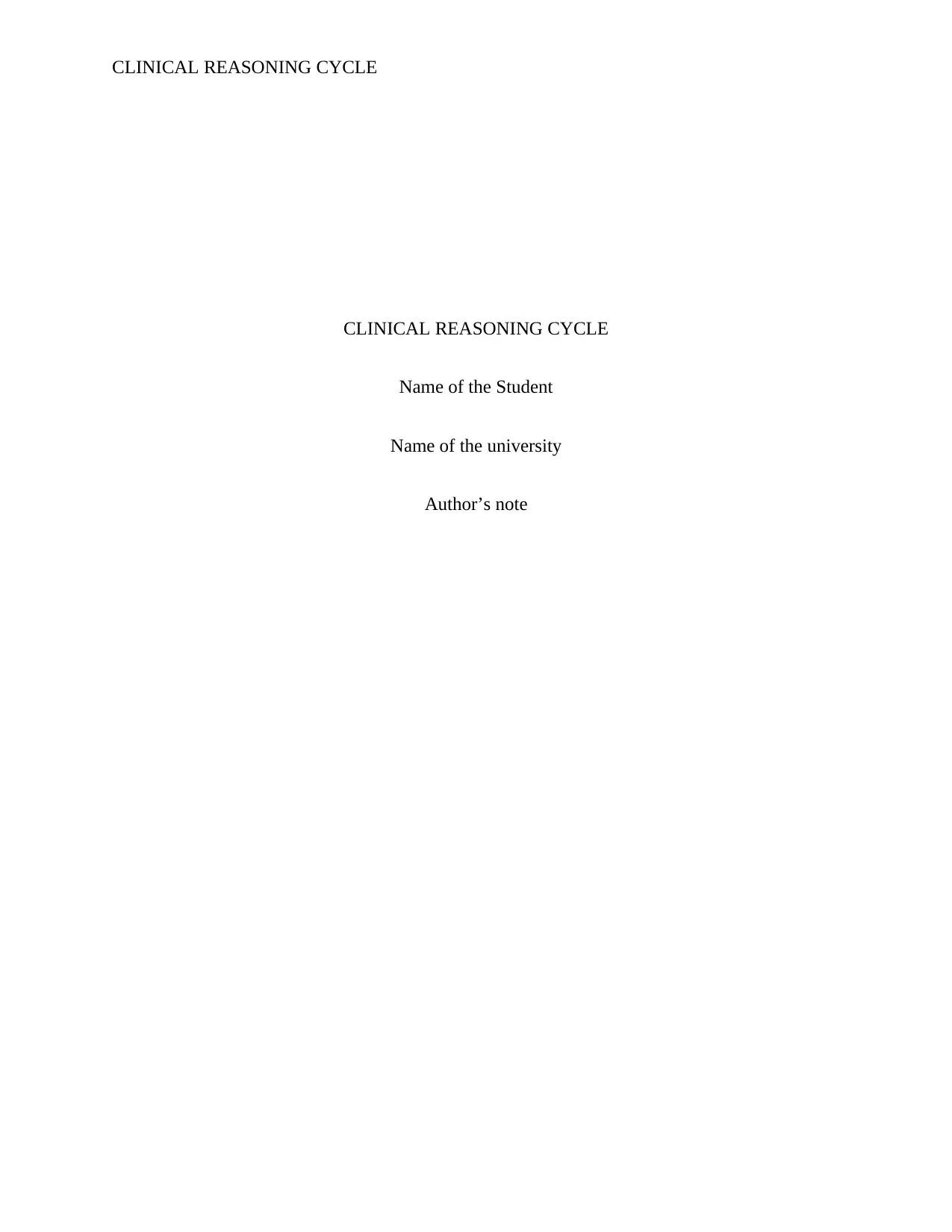
CLINICAL REASONING CYCLE
CLINICAL REASONING CYCLE
Name of the Student
Name of the university
Author’s note
CLINICAL REASONING CYCLE
Name of the Student
Name of the university
Author’s note
Paraphrase This Document
Need a fresh take? Get an instant paraphrase of this document with our AI Paraphraser
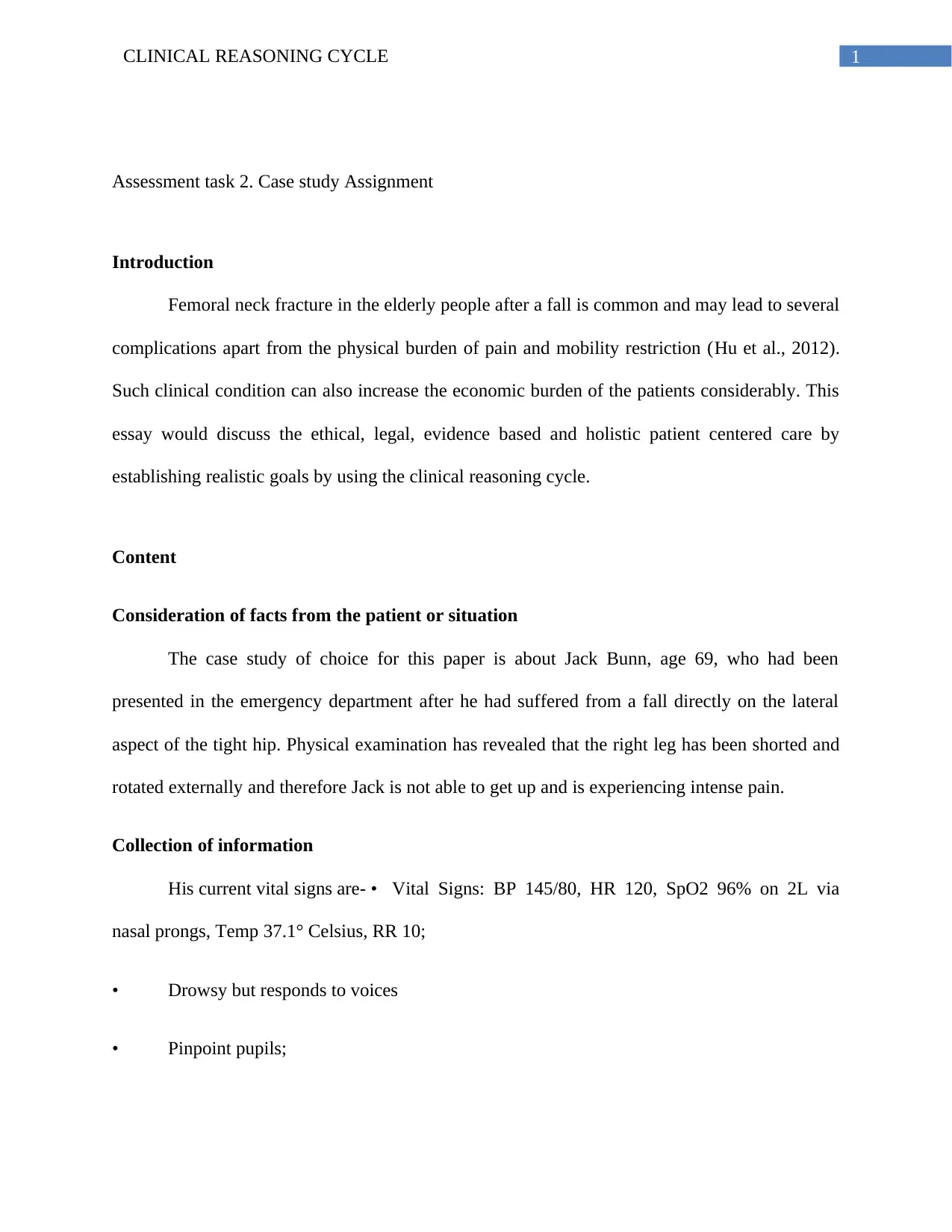
1CLINICAL REASONING CYCLE
Assessment task 2. Case study Assignment
Introduction
Femoral neck fracture in the elderly people after a fall is common and may lead to several
complications apart from the physical burden of pain and mobility restriction (Hu et al., 2012).
Such clinical condition can also increase the economic burden of the patients considerably. This
essay would discuss the ethical, legal, evidence based and holistic patient centered care by
establishing realistic goals by using the clinical reasoning cycle.
Content
Consideration of facts from the patient or situation
The case study of choice for this paper is about Jack Bunn, age 69, who had been
presented in the emergency department after he had suffered from a fall directly on the lateral
aspect of the tight hip. Physical examination has revealed that the right leg has been shorted and
rotated externally and therefore Jack is not able to get up and is experiencing intense pain.
Collection of information
His current vital signs are- • Vital Signs: BP 145/80, HR 120, SpO2 96% on 2L via
nasal prongs, Temp 37.1° Celsius, RR 10;
• Drowsy but responds to voices
• Pinpoint pupils;
Assessment task 2. Case study Assignment
Introduction
Femoral neck fracture in the elderly people after a fall is common and may lead to several
complications apart from the physical burden of pain and mobility restriction (Hu et al., 2012).
Such clinical condition can also increase the economic burden of the patients considerably. This
essay would discuss the ethical, legal, evidence based and holistic patient centered care by
establishing realistic goals by using the clinical reasoning cycle.
Content
Consideration of facts from the patient or situation
The case study of choice for this paper is about Jack Bunn, age 69, who had been
presented in the emergency department after he had suffered from a fall directly on the lateral
aspect of the tight hip. Physical examination has revealed that the right leg has been shorted and
rotated externally and therefore Jack is not able to get up and is experiencing intense pain.
Collection of information
His current vital signs are- • Vital Signs: BP 145/80, HR 120, SpO2 96% on 2L via
nasal prongs, Temp 37.1° Celsius, RR 10;
• Drowsy but responds to voices
• Pinpoint pupils;
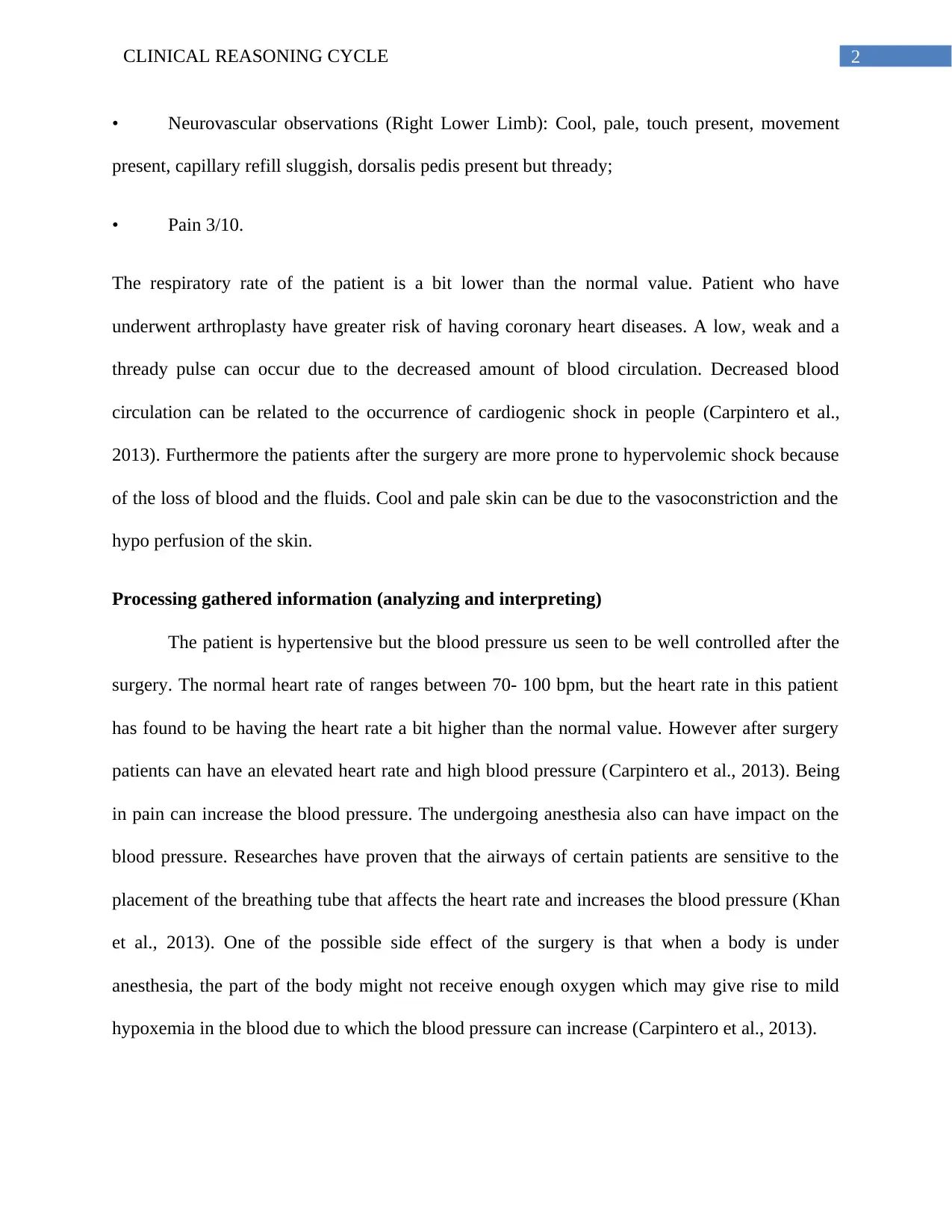
2CLINICAL REASONING CYCLE
• Neurovascular observations (Right Lower Limb): Cool, pale, touch present, movement
present, capillary refill sluggish, dorsalis pedis present but thready;
• Pain 3/10.
The respiratory rate of the patient is a bit lower than the normal value. Patient who have
underwent arthroplasty have greater risk of having coronary heart diseases. A low, weak and a
thready pulse can occur due to the decreased amount of blood circulation. Decreased blood
circulation can be related to the occurrence of cardiogenic shock in people (Carpintero et al.,
2013). Furthermore the patients after the surgery are more prone to hypervolemic shock because
of the loss of blood and the fluids. Cool and pale skin can be due to the vasoconstriction and the
hypo perfusion of the skin.
Processing gathered information (analyzing and interpreting)
The patient is hypertensive but the blood pressure us seen to be well controlled after the
surgery. The normal heart rate of ranges between 70- 100 bpm, but the heart rate in this patient
has found to be having the heart rate a bit higher than the normal value. However after surgery
patients can have an elevated heart rate and high blood pressure (Carpintero et al., 2013). Being
in pain can increase the blood pressure. The undergoing anesthesia also can have impact on the
blood pressure. Researches have proven that the airways of certain patients are sensitive to the
placement of the breathing tube that affects the heart rate and increases the blood pressure (Khan
et al., 2013). One of the possible side effect of the surgery is that when a body is under
anesthesia, the part of the body might not receive enough oxygen which may give rise to mild
hypoxemia in the blood due to which the blood pressure can increase (Carpintero et al., 2013).
• Neurovascular observations (Right Lower Limb): Cool, pale, touch present, movement
present, capillary refill sluggish, dorsalis pedis present but thready;
• Pain 3/10.
The respiratory rate of the patient is a bit lower than the normal value. Patient who have
underwent arthroplasty have greater risk of having coronary heart diseases. A low, weak and a
thready pulse can occur due to the decreased amount of blood circulation. Decreased blood
circulation can be related to the occurrence of cardiogenic shock in people (Carpintero et al.,
2013). Furthermore the patients after the surgery are more prone to hypervolemic shock because
of the loss of blood and the fluids. Cool and pale skin can be due to the vasoconstriction and the
hypo perfusion of the skin.
Processing gathered information (analyzing and interpreting)
The patient is hypertensive but the blood pressure us seen to be well controlled after the
surgery. The normal heart rate of ranges between 70- 100 bpm, but the heart rate in this patient
has found to be having the heart rate a bit higher than the normal value. However after surgery
patients can have an elevated heart rate and high blood pressure (Carpintero et al., 2013). Being
in pain can increase the blood pressure. The undergoing anesthesia also can have impact on the
blood pressure. Researches have proven that the airways of certain patients are sensitive to the
placement of the breathing tube that affects the heart rate and increases the blood pressure (Khan
et al., 2013). One of the possible side effect of the surgery is that when a body is under
anesthesia, the part of the body might not receive enough oxygen which may give rise to mild
hypoxemia in the blood due to which the blood pressure can increase (Carpintero et al., 2013).
⊘ This is a preview!⊘
Do you want full access?
Subscribe today to unlock all pages.

Trusted by 1+ million students worldwide
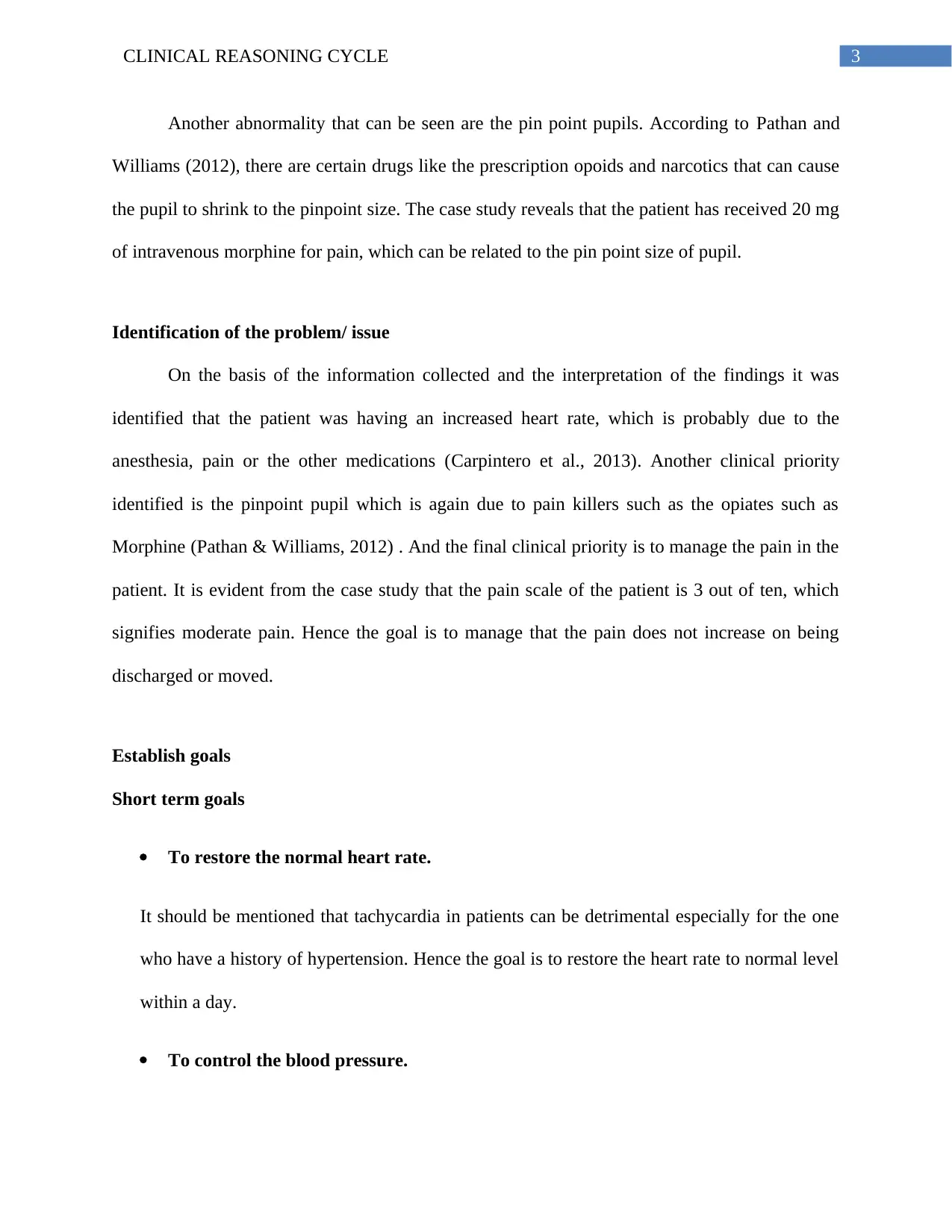
3CLINICAL REASONING CYCLE
Another abnormality that can be seen are the pin point pupils. According to Pathan and
Williams (2012), there are certain drugs like the prescription opoids and narcotics that can cause
the pupil to shrink to the pinpoint size. The case study reveals that the patient has received 20 mg
of intravenous morphine for pain, which can be related to the pin point size of pupil.
Identification of the problem/ issue
On the basis of the information collected and the interpretation of the findings it was
identified that the patient was having an increased heart rate, which is probably due to the
anesthesia, pain or the other medications (Carpintero et al., 2013). Another clinical priority
identified is the pinpoint pupil which is again due to pain killers such as the opiates such as
Morphine (Pathan & Williams, 2012) . And the final clinical priority is to manage the pain in the
patient. It is evident from the case study that the pain scale of the patient is 3 out of ten, which
signifies moderate pain. Hence the goal is to manage that the pain does not increase on being
discharged or moved.
Establish goals
Short term goals
To restore the normal heart rate.
It should be mentioned that tachycardia in patients can be detrimental especially for the one
who have a history of hypertension. Hence the goal is to restore the heart rate to normal level
within a day.
To control the blood pressure.
Another abnormality that can be seen are the pin point pupils. According to Pathan and
Williams (2012), there are certain drugs like the prescription opoids and narcotics that can cause
the pupil to shrink to the pinpoint size. The case study reveals that the patient has received 20 mg
of intravenous morphine for pain, which can be related to the pin point size of pupil.
Identification of the problem/ issue
On the basis of the information collected and the interpretation of the findings it was
identified that the patient was having an increased heart rate, which is probably due to the
anesthesia, pain or the other medications (Carpintero et al., 2013). Another clinical priority
identified is the pinpoint pupil which is again due to pain killers such as the opiates such as
Morphine (Pathan & Williams, 2012) . And the final clinical priority is to manage the pain in the
patient. It is evident from the case study that the pain scale of the patient is 3 out of ten, which
signifies moderate pain. Hence the goal is to manage that the pain does not increase on being
discharged or moved.
Establish goals
Short term goals
To restore the normal heart rate.
It should be mentioned that tachycardia in patients can be detrimental especially for the one
who have a history of hypertension. Hence the goal is to restore the heart rate to normal level
within a day.
To control the blood pressure.
Paraphrase This Document
Need a fresh take? Get an instant paraphrase of this document with our AI Paraphraser
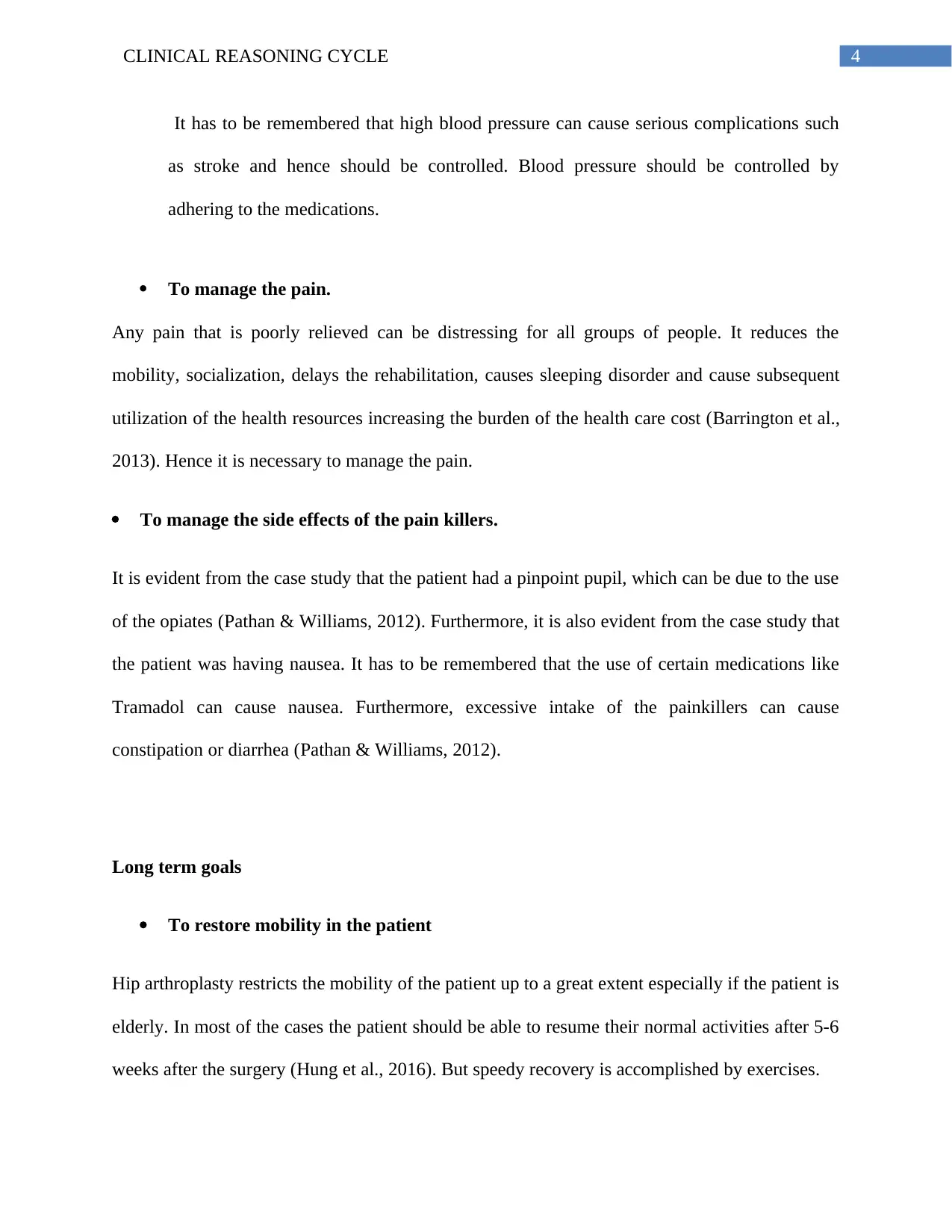
4CLINICAL REASONING CYCLE
It has to be remembered that high blood pressure can cause serious complications such
as stroke and hence should be controlled. Blood pressure should be controlled by
adhering to the medications.
To manage the pain.
Any pain that is poorly relieved can be distressing for all groups of people. It reduces the
mobility, socialization, delays the rehabilitation, causes sleeping disorder and cause subsequent
utilization of the health resources increasing the burden of the health care cost (Barrington et al.,
2013). Hence it is necessary to manage the pain.
To manage the side effects of the pain killers.
It is evident from the case study that the patient had a pinpoint pupil, which can be due to the use
of the opiates (Pathan & Williams, 2012). Furthermore, it is also evident from the case study that
the patient was having nausea. It has to be remembered that the use of certain medications like
Tramadol can cause nausea. Furthermore, excessive intake of the painkillers can cause
constipation or diarrhea (Pathan & Williams, 2012).
Long term goals
To restore mobility in the patient
Hip arthroplasty restricts the mobility of the patient up to a great extent especially if the patient is
elderly. In most of the cases the patient should be able to resume their normal activities after 5-6
weeks after the surgery (Hung et al., 2016). But speedy recovery is accomplished by exercises.
It has to be remembered that high blood pressure can cause serious complications such
as stroke and hence should be controlled. Blood pressure should be controlled by
adhering to the medications.
To manage the pain.
Any pain that is poorly relieved can be distressing for all groups of people. It reduces the
mobility, socialization, delays the rehabilitation, causes sleeping disorder and cause subsequent
utilization of the health resources increasing the burden of the health care cost (Barrington et al.,
2013). Hence it is necessary to manage the pain.
To manage the side effects of the pain killers.
It is evident from the case study that the patient had a pinpoint pupil, which can be due to the use
of the opiates (Pathan & Williams, 2012). Furthermore, it is also evident from the case study that
the patient was having nausea. It has to be remembered that the use of certain medications like
Tramadol can cause nausea. Furthermore, excessive intake of the painkillers can cause
constipation or diarrhea (Pathan & Williams, 2012).
Long term goals
To restore mobility in the patient
Hip arthroplasty restricts the mobility of the patient up to a great extent especially if the patient is
elderly. In most of the cases the patient should be able to resume their normal activities after 5-6
weeks after the surgery (Hung et al., 2016). But speedy recovery is accomplished by exercises.
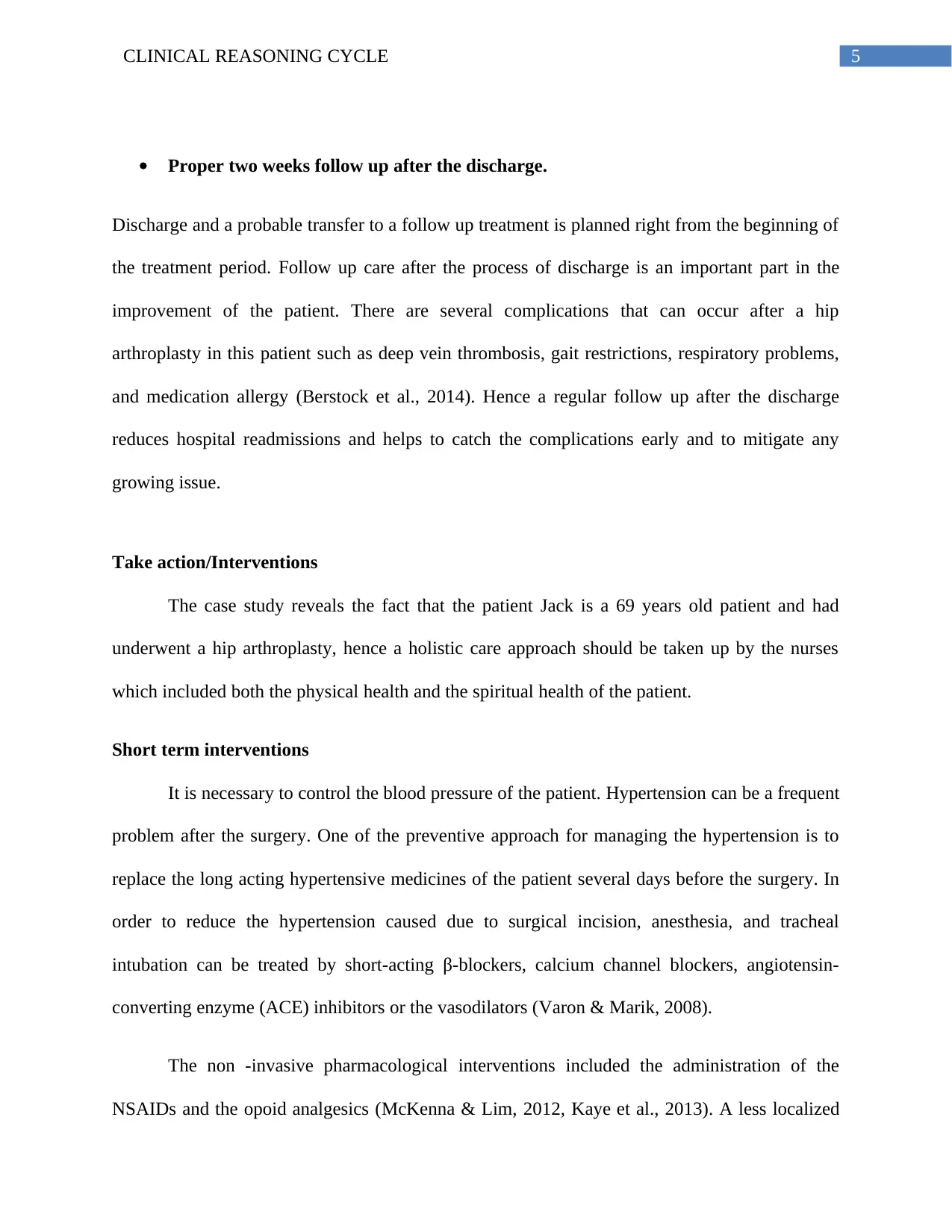
5CLINICAL REASONING CYCLE
Proper two weeks follow up after the discharge.
Discharge and a probable transfer to a follow up treatment is planned right from the beginning of
the treatment period. Follow up care after the process of discharge is an important part in the
improvement of the patient. There are several complications that can occur after a hip
arthroplasty in this patient such as deep vein thrombosis, gait restrictions, respiratory problems,
and medication allergy (Berstock et al., 2014). Hence a regular follow up after the discharge
reduces hospital readmissions and helps to catch the complications early and to mitigate any
growing issue.
Take action/Interventions
The case study reveals the fact that the patient Jack is a 69 years old patient and had
underwent a hip arthroplasty, hence a holistic care approach should be taken up by the nurses
which included both the physical health and the spiritual health of the patient.
Short term interventions
It is necessary to control the blood pressure of the patient. Hypertension can be a frequent
problem after the surgery. One of the preventive approach for managing the hypertension is to
replace the long acting hypertensive medicines of the patient several days before the surgery. In
order to reduce the hypertension caused due to surgical incision, anesthesia, and tracheal
intubation can be treated by short-acting β-blockers, calcium channel blockers, angiotensin-
converting enzyme (ACE) inhibitors or the vasodilators (Varon & Marik, 2008).
The non -invasive pharmacological interventions included the administration of the
NSAIDs and the opoid analgesics (McKenna & Lim, 2012, Kaye et al., 2013). A less localized
Proper two weeks follow up after the discharge.
Discharge and a probable transfer to a follow up treatment is planned right from the beginning of
the treatment period. Follow up care after the process of discharge is an important part in the
improvement of the patient. There are several complications that can occur after a hip
arthroplasty in this patient such as deep vein thrombosis, gait restrictions, respiratory problems,
and medication allergy (Berstock et al., 2014). Hence a regular follow up after the discharge
reduces hospital readmissions and helps to catch the complications early and to mitigate any
growing issue.
Take action/Interventions
The case study reveals the fact that the patient Jack is a 69 years old patient and had
underwent a hip arthroplasty, hence a holistic care approach should be taken up by the nurses
which included both the physical health and the spiritual health of the patient.
Short term interventions
It is necessary to control the blood pressure of the patient. Hypertension can be a frequent
problem after the surgery. One of the preventive approach for managing the hypertension is to
replace the long acting hypertensive medicines of the patient several days before the surgery. In
order to reduce the hypertension caused due to surgical incision, anesthesia, and tracheal
intubation can be treated by short-acting β-blockers, calcium channel blockers, angiotensin-
converting enzyme (ACE) inhibitors or the vasodilators (Varon & Marik, 2008).
The non -invasive pharmacological interventions included the administration of the
NSAIDs and the opoid analgesics (McKenna & Lim, 2012, Kaye et al., 2013). A less localized
⊘ This is a preview!⊘
Do you want full access?
Subscribe today to unlock all pages.

Trusted by 1+ million students worldwide
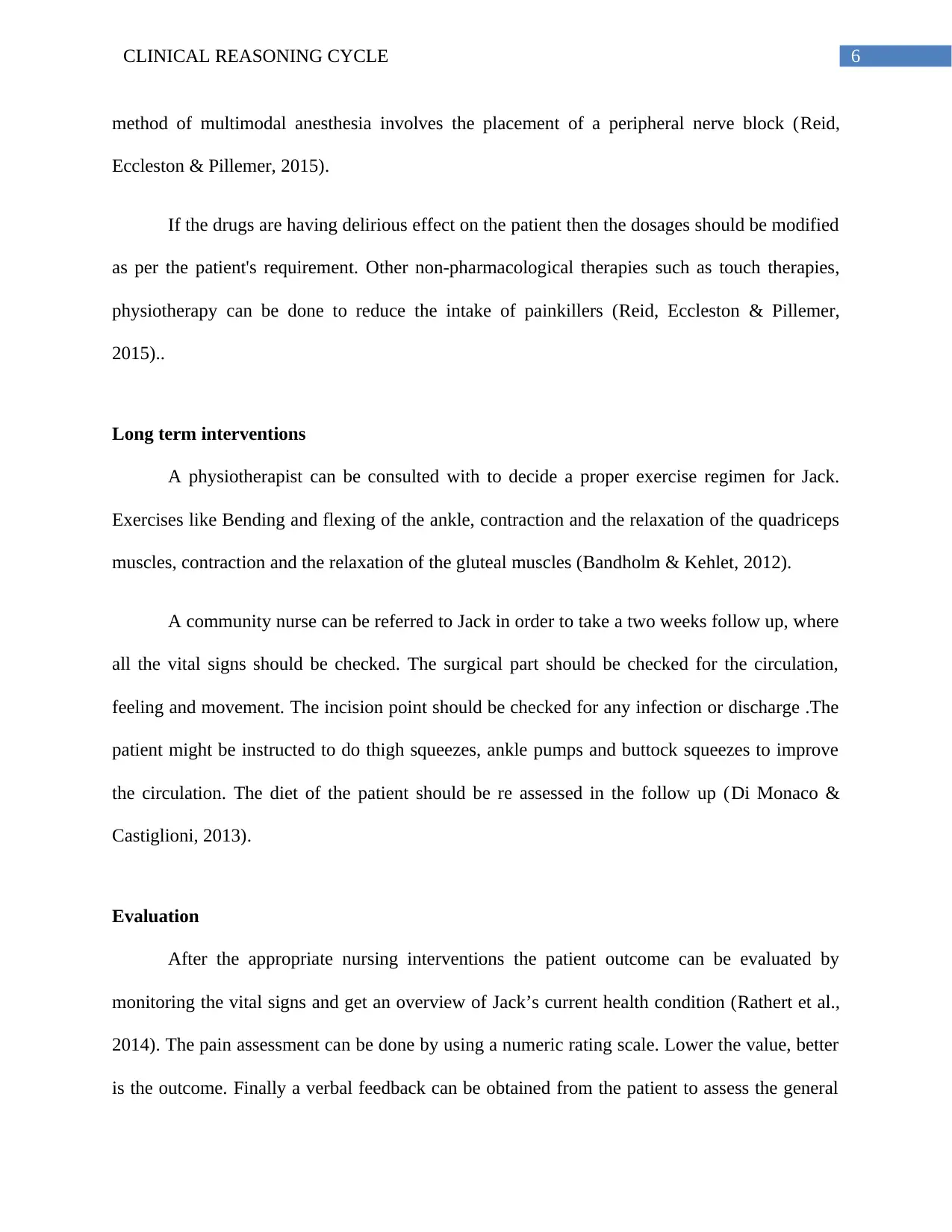
6CLINICAL REASONING CYCLE
method of multimodal anesthesia involves the placement of a peripheral nerve block (Reid,
Eccleston & Pillemer, 2015).
If the drugs are having delirious effect on the patient then the dosages should be modified
as per the patient's requirement. Other non-pharmacological therapies such as touch therapies,
physiotherapy can be done to reduce the intake of painkillers (Reid, Eccleston & Pillemer,
2015)..
Long term interventions
A physiotherapist can be consulted with to decide a proper exercise regimen for Jack.
Exercises like Bending and flexing of the ankle, contraction and the relaxation of the quadriceps
muscles, contraction and the relaxation of the gluteal muscles (Bandholm & Kehlet, 2012).
A community nurse can be referred to Jack in order to take a two weeks follow up, where
all the vital signs should be checked. The surgical part should be checked for the circulation,
feeling and movement. The incision point should be checked for any infection or discharge .The
patient might be instructed to do thigh squeezes, ankle pumps and buttock squeezes to improve
the circulation. The diet of the patient should be re assessed in the follow up (Di Monaco &
Castiglioni, 2013).
Evaluation
After the appropriate nursing interventions the patient outcome can be evaluated by
monitoring the vital signs and get an overview of Jack’s current health condition (Rathert et al.,
2014). The pain assessment can be done by using a numeric rating scale. Lower the value, better
is the outcome. Finally a verbal feedback can be obtained from the patient to assess the general
method of multimodal anesthesia involves the placement of a peripheral nerve block (Reid,
Eccleston & Pillemer, 2015).
If the drugs are having delirious effect on the patient then the dosages should be modified
as per the patient's requirement. Other non-pharmacological therapies such as touch therapies,
physiotherapy can be done to reduce the intake of painkillers (Reid, Eccleston & Pillemer,
2015)..
Long term interventions
A physiotherapist can be consulted with to decide a proper exercise regimen for Jack.
Exercises like Bending and flexing of the ankle, contraction and the relaxation of the quadriceps
muscles, contraction and the relaxation of the gluteal muscles (Bandholm & Kehlet, 2012).
A community nurse can be referred to Jack in order to take a two weeks follow up, where
all the vital signs should be checked. The surgical part should be checked for the circulation,
feeling and movement. The incision point should be checked for any infection or discharge .The
patient might be instructed to do thigh squeezes, ankle pumps and buttock squeezes to improve
the circulation. The diet of the patient should be re assessed in the follow up (Di Monaco &
Castiglioni, 2013).
Evaluation
After the appropriate nursing interventions the patient outcome can be evaluated by
monitoring the vital signs and get an overview of Jack’s current health condition (Rathert et al.,
2014). The pain assessment can be done by using a numeric rating scale. Lower the value, better
is the outcome. Finally a verbal feedback can be obtained from the patient to assess the general
Paraphrase This Document
Need a fresh take? Get an instant paraphrase of this document with our AI Paraphraser
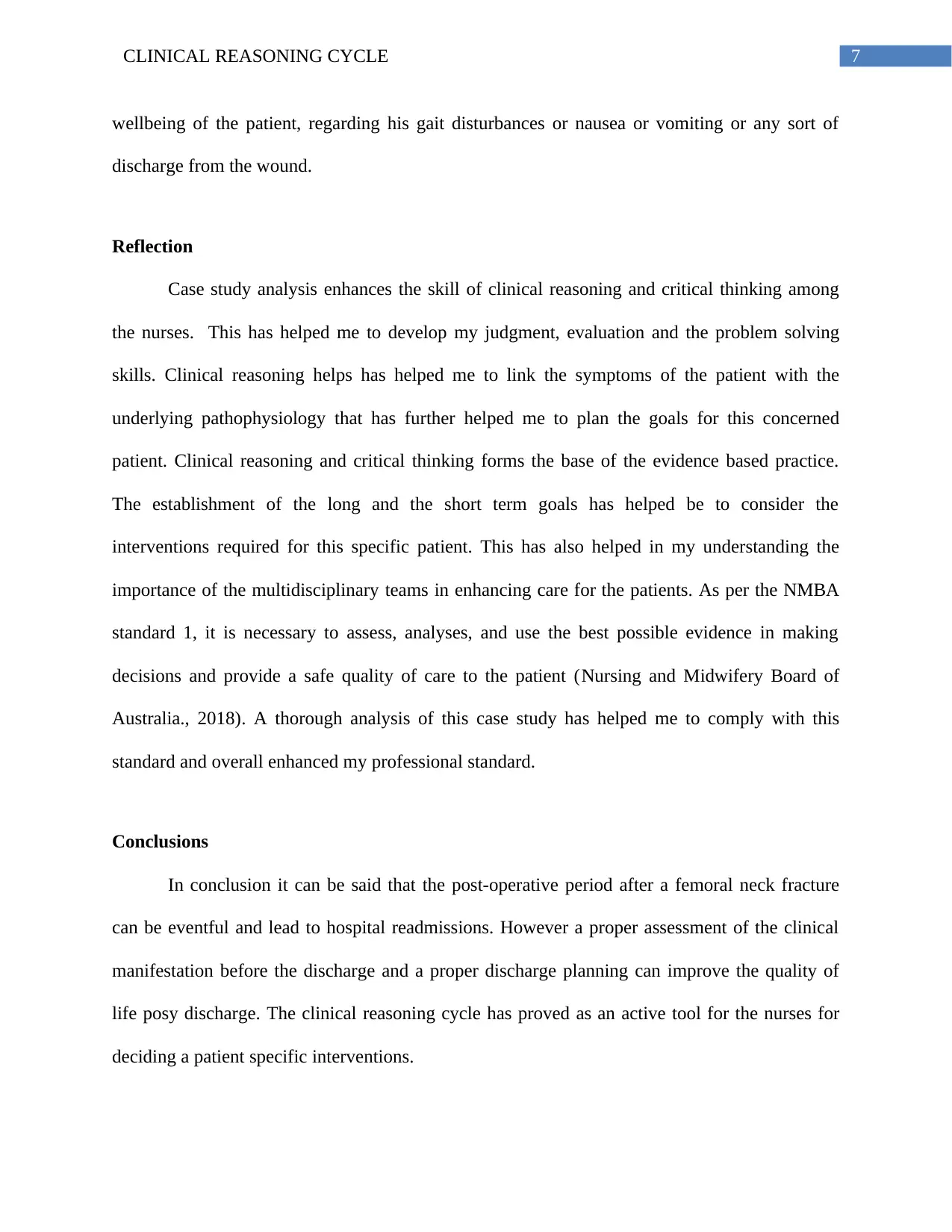
7CLINICAL REASONING CYCLE
wellbeing of the patient, regarding his gait disturbances or nausea or vomiting or any sort of
discharge from the wound.
Reflection
Case study analysis enhances the skill of clinical reasoning and critical thinking among
the nurses. This has helped me to develop my judgment, evaluation and the problem solving
skills. Clinical reasoning helps has helped me to link the symptoms of the patient with the
underlying pathophysiology that has further helped me to plan the goals for this concerned
patient. Clinical reasoning and critical thinking forms the base of the evidence based practice.
The establishment of the long and the short term goals has helped be to consider the
interventions required for this specific patient. This has also helped in my understanding the
importance of the multidisciplinary teams in enhancing care for the patients. As per the NMBA
standard 1, it is necessary to assess, analyses, and use the best possible evidence in making
decisions and provide a safe quality of care to the patient (Nursing and Midwifery Board of
Australia., 2018). A thorough analysis of this case study has helped me to comply with this
standard and overall enhanced my professional standard.
Conclusions
In conclusion it can be said that the post-operative period after a femoral neck fracture
can be eventful and lead to hospital readmissions. However a proper assessment of the clinical
manifestation before the discharge and a proper discharge planning can improve the quality of
life posy discharge. The clinical reasoning cycle has proved as an active tool for the nurses for
deciding a patient specific interventions.
wellbeing of the patient, regarding his gait disturbances or nausea or vomiting or any sort of
discharge from the wound.
Reflection
Case study analysis enhances the skill of clinical reasoning and critical thinking among
the nurses. This has helped me to develop my judgment, evaluation and the problem solving
skills. Clinical reasoning helps has helped me to link the symptoms of the patient with the
underlying pathophysiology that has further helped me to plan the goals for this concerned
patient. Clinical reasoning and critical thinking forms the base of the evidence based practice.
The establishment of the long and the short term goals has helped be to consider the
interventions required for this specific patient. This has also helped in my understanding the
importance of the multidisciplinary teams in enhancing care for the patients. As per the NMBA
standard 1, it is necessary to assess, analyses, and use the best possible evidence in making
decisions and provide a safe quality of care to the patient (Nursing and Midwifery Board of
Australia., 2018). A thorough analysis of this case study has helped me to comply with this
standard and overall enhanced my professional standard.
Conclusions
In conclusion it can be said that the post-operative period after a femoral neck fracture
can be eventful and lead to hospital readmissions. However a proper assessment of the clinical
manifestation before the discharge and a proper discharge planning can improve the quality of
life posy discharge. The clinical reasoning cycle has proved as an active tool for the nurses for
deciding a patient specific interventions.
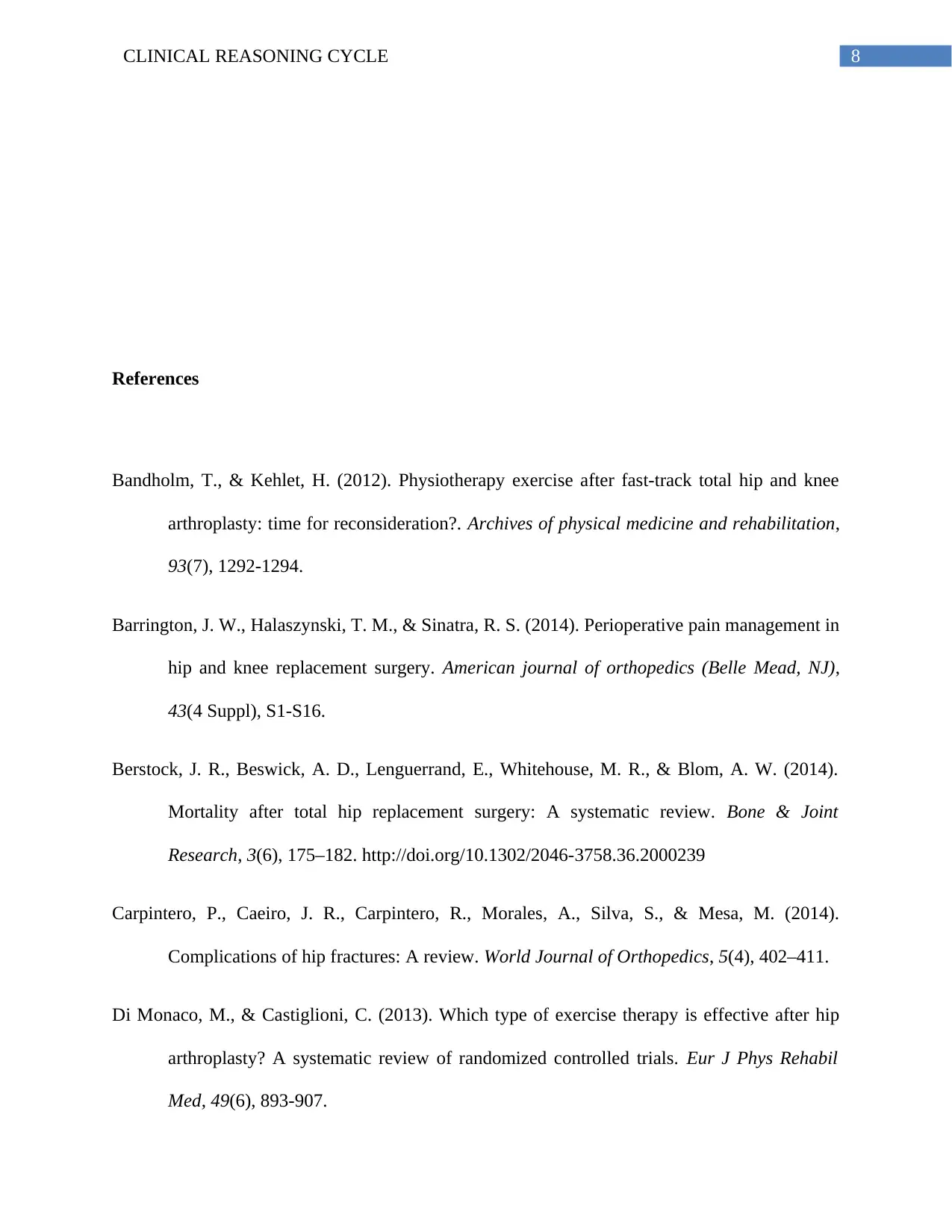
8CLINICAL REASONING CYCLE
References
Bandholm, T., & Kehlet, H. (2012). Physiotherapy exercise after fast-track total hip and knee
arthroplasty: time for reconsideration?. Archives of physical medicine and rehabilitation,
93(7), 1292-1294.
Barrington, J. W., Halaszynski, T. M., & Sinatra, R. S. (2014). Perioperative pain management in
hip and knee replacement surgery. American journal of orthopedics (Belle Mead, NJ),
43(4 Suppl), S1-S16.
Berstock, J. R., Beswick, A. D., Lenguerrand, E., Whitehouse, M. R., & Blom, A. W. (2014).
Mortality after total hip replacement surgery: A systematic review. Bone & Joint
Research, 3(6), 175–182. http://doi.org/10.1302/2046-3758.36.2000239
Carpintero, P., Caeiro, J. R., Carpintero, R., Morales, A., Silva, S., & Mesa, M. (2014).
Complications of hip fractures: A review. World Journal of Orthopedics, 5(4), 402–411.
Di Monaco, M., & Castiglioni, C. (2013). Which type of exercise therapy is effective after hip
arthroplasty? A systematic review of randomized controlled trials. Eur J Phys Rehabil
Med, 49(6), 893-907.
References
Bandholm, T., & Kehlet, H. (2012). Physiotherapy exercise after fast-track total hip and knee
arthroplasty: time for reconsideration?. Archives of physical medicine and rehabilitation,
93(7), 1292-1294.
Barrington, J. W., Halaszynski, T. M., & Sinatra, R. S. (2014). Perioperative pain management in
hip and knee replacement surgery. American journal of orthopedics (Belle Mead, NJ),
43(4 Suppl), S1-S16.
Berstock, J. R., Beswick, A. D., Lenguerrand, E., Whitehouse, M. R., & Blom, A. W. (2014).
Mortality after total hip replacement surgery: A systematic review. Bone & Joint
Research, 3(6), 175–182. http://doi.org/10.1302/2046-3758.36.2000239
Carpintero, P., Caeiro, J. R., Carpintero, R., Morales, A., Silva, S., & Mesa, M. (2014).
Complications of hip fractures: A review. World Journal of Orthopedics, 5(4), 402–411.
Di Monaco, M., & Castiglioni, C. (2013). Which type of exercise therapy is effective after hip
arthroplasty? A systematic review of randomized controlled trials. Eur J Phys Rehabil
Med, 49(6), 893-907.
⊘ This is a preview!⊘
Do you want full access?
Subscribe today to unlock all pages.

Trusted by 1+ million students worldwide
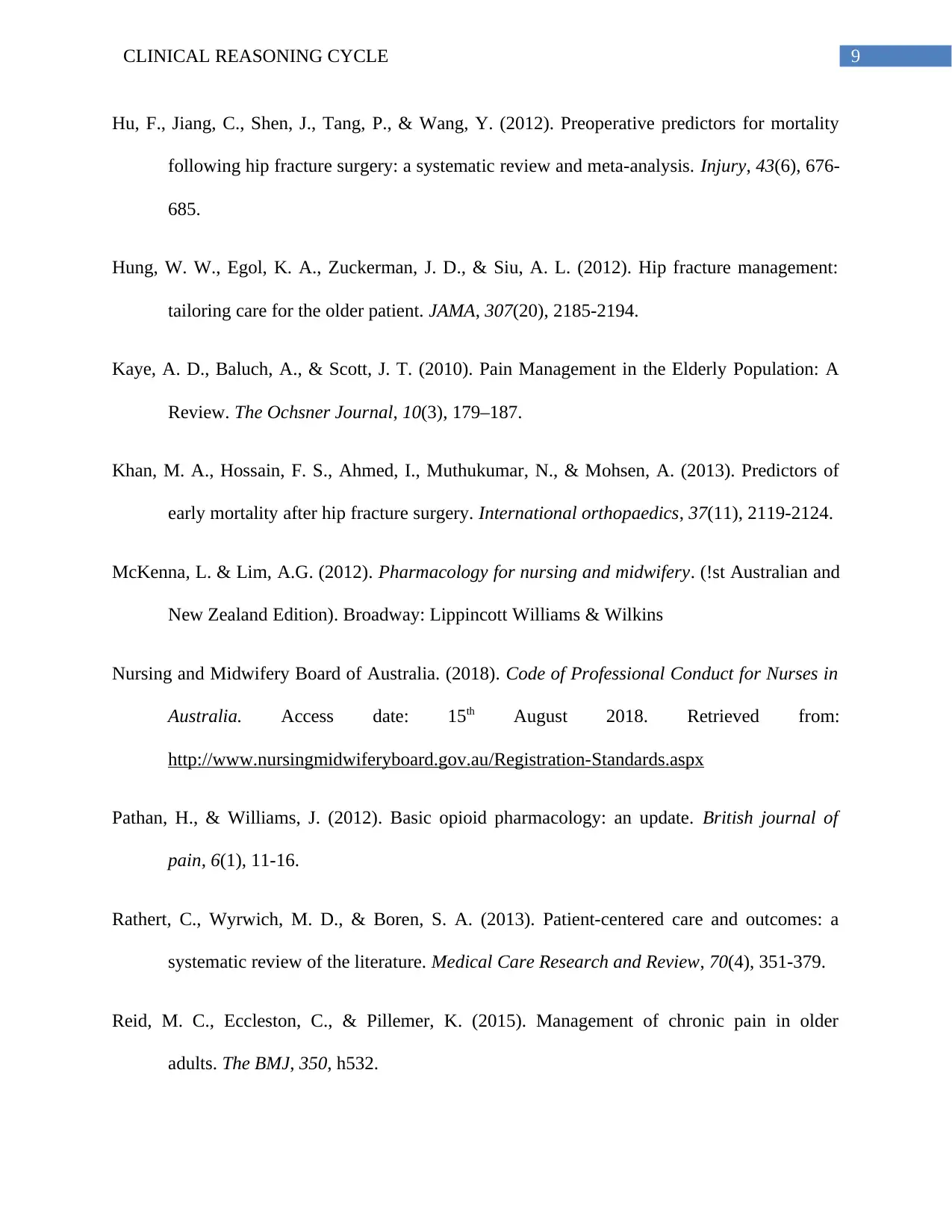
9CLINICAL REASONING CYCLE
Hu, F., Jiang, C., Shen, J., Tang, P., & Wang, Y. (2012). Preoperative predictors for mortality
following hip fracture surgery: a systematic review and meta-analysis. Injury, 43(6), 676-
685.
Hung, W. W., Egol, K. A., Zuckerman, J. D., & Siu, A. L. (2012). Hip fracture management:
tailoring care for the older patient. JAMA, 307(20), 2185-2194.
Kaye, A. D., Baluch, A., & Scott, J. T. (2010). Pain Management in the Elderly Population: A
Review. The Ochsner Journal, 10(3), 179–187.
Khan, M. A., Hossain, F. S., Ahmed, I., Muthukumar, N., & Mohsen, A. (2013). Predictors of
early mortality after hip fracture surgery. International orthopaedics, 37(11), 2119-2124.
McKenna, L. & Lim, A.G. (2012). Pharmacology for nursing and midwifery. (!st Australian and
New Zealand Edition). Broadway: Lippincott Williams & Wilkins
Nursing and Midwifery Board of Australia. (2018). Code of Professional Conduct for Nurses in
Australia. Access date: 15th August 2018. Retrieved from:
http://www.nursingmidwiferyboard.gov.au/Registration-Standards.aspx
Pathan, H., & Williams, J. (2012). Basic opioid pharmacology: an update. British journal of
pain, 6(1), 11-16.
Rathert, C., Wyrwich, M. D., & Boren, S. A. (2013). Patient-centered care and outcomes: a
systematic review of the literature. Medical Care Research and Review, 70(4), 351-379.
Reid, M. C., Eccleston, C., & Pillemer, K. (2015). Management of chronic pain in older
adults. The BMJ, 350, h532.
Hu, F., Jiang, C., Shen, J., Tang, P., & Wang, Y. (2012). Preoperative predictors for mortality
following hip fracture surgery: a systematic review and meta-analysis. Injury, 43(6), 676-
685.
Hung, W. W., Egol, K. A., Zuckerman, J. D., & Siu, A. L. (2012). Hip fracture management:
tailoring care for the older patient. JAMA, 307(20), 2185-2194.
Kaye, A. D., Baluch, A., & Scott, J. T. (2010). Pain Management in the Elderly Population: A
Review. The Ochsner Journal, 10(3), 179–187.
Khan, M. A., Hossain, F. S., Ahmed, I., Muthukumar, N., & Mohsen, A. (2013). Predictors of
early mortality after hip fracture surgery. International orthopaedics, 37(11), 2119-2124.
McKenna, L. & Lim, A.G. (2012). Pharmacology for nursing and midwifery. (!st Australian and
New Zealand Edition). Broadway: Lippincott Williams & Wilkins
Nursing and Midwifery Board of Australia. (2018). Code of Professional Conduct for Nurses in
Australia. Access date: 15th August 2018. Retrieved from:
http://www.nursingmidwiferyboard.gov.au/Registration-Standards.aspx
Pathan, H., & Williams, J. (2012). Basic opioid pharmacology: an update. British journal of
pain, 6(1), 11-16.
Rathert, C., Wyrwich, M. D., & Boren, S. A. (2013). Patient-centered care and outcomes: a
systematic review of the literature. Medical Care Research and Review, 70(4), 351-379.
Reid, M. C., Eccleston, C., & Pillemer, K. (2015). Management of chronic pain in older
adults. The BMJ, 350, h532.
Paraphrase This Document
Need a fresh take? Get an instant paraphrase of this document with our AI Paraphraser

10CLINICAL REASONING CYCLE
Varon, J., & Marik, P. E. (2008). Perioperative hypertension management. Vascular Health and
Risk Management, 4(3), 615–627.
Varon, J., & Marik, P. E. (2008). Perioperative hypertension management. Vascular Health and
Risk Management, 4(3), 615–627.
1 out of 11
Related Documents
Your All-in-One AI-Powered Toolkit for Academic Success.
+13062052269
info@desklib.com
Available 24*7 on WhatsApp / Email
![[object Object]](/_next/static/media/star-bottom.7253800d.svg)
Unlock your academic potential
Copyright © 2020–2025 A2Z Services. All Rights Reserved. Developed and managed by ZUCOL.





